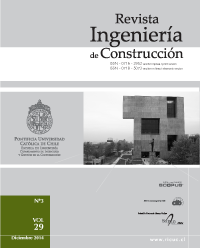High energy milling (HEM) of Mexican minerals to produce high performance concrete (HPC)
DOI:
https://doi.org/10.4067/S0718-50732014000300003Keywords:
High energy milling (HEM), high performance concrete (HPC), composed Portland cement (CPC), and Mexican fine aggregatesAbstract
In order to produce high performance concrete (HPC), fine Mexican mineral aggregates were characterized using chemical, physical and mineralogical procedures. Used materials included fly-ash, micro silica, silica fume, and coarse, fine and refined ground granulated blast furnace slag (GGBS), which were then dosed with Composite Portland Cement (CPC) in three forms: (1) commercially as-received, (2) as-screened and (3) after being high energy ball milled (HEM), i.e., as-milled. The materials were conditioned with less than 200 mesh (75µm) particles and with submicron particle sizes in order to analyze their contribution to the compressive strength of the paste. After characterizing the raw materials, the experimental parameters for reducing particle sizes by HEM - CPC and GGBS were determined. Milled products and other cementitious materials were characterized by X-ray diffraction (XRD), scanning electron microscopy (SEM) and atomic absorption analyses. Different materials phases were identified, thus observing a change in the mass percentage of Alite C3 S and Belite C2 S, which promote the compressive strength of the specimens produced, provided that the CPC has been grounded by HEM for 30 min. Silica fume was proven to the best aggregate, which triggers the compressive strength of the specimens prepared.


